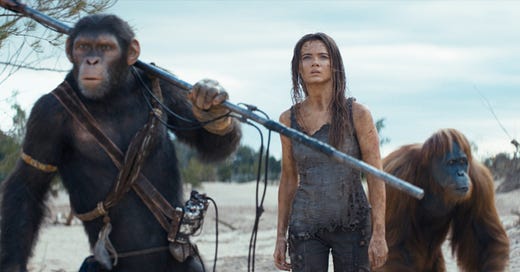(back after a brief, Venice-induced hiatus; to make up for it, there will be three posts this week, from Friday to Sunday)
On August 27, Kingdom of the Planet of the Apes, the fourth (and very good) installment in the rebooted Planet of the Apes film series, was released on home video, after already being available on PVOD (premium video on demand) and Disney+/Hulu. While the latter option only comes with a trailer, the Blu-ray is very much worth seeking out for one bonus feature in particular, the kind of extra material most big studios sadly no longer put any effort into.
Specifically, the Blu-ray editions of the film include a version called the Raw Cut: the finished movie plays side by side with footage containing the actors’ performances before the visual effects were added. It’s a fascinating glimpse into how this kind of project is brought to life, combining the skill of the physical performers and the talent of the VFX artists.
Such a viewing mode is a valuable asset in the context of understanding how performance capture – whereby actors wear special suits and trackers that serve as a reference for the digital aspect - works: from personal experience, I still occasionally come across people who view it as glorified voice acting (of course, these commenters also think the latter is not real acting), a viewpoint fed by the technology’s use in some animated films – most notably the ones by Robert Zemeckis – as well as sites like IMDb erroneously adding “(voice)” next to the roles on the pages of films containing performance capture work.
The rebooted Apes movies (the first films to use performance capture on location rather than in a bespoke studio) made a point of highlighting what the technique entails on multiple occasions, most notably in a video released to promote the third installment in 2017, with a demonstration of how the technology was progressively applied to the acting work of Andy Serkis to create the character of Caesar, a perfect blend of physical human performance and CGI.
It is also fitting that something like the Raw Cut be made available for a Planet of the Apes movie, given the franchise’s history with various degrees of advanced trickery to bring the titular simians to life: back in 1969, John Chambers’ groundbreaking make-up earned him an honorary Oscar (the regular category did not exist yet), and the modern equivalent in the 2001 Tim Burton movie is among the finest achievements of Rick Baker’s career.
And yet, there was always the elephant in the room: impeccable though they were, it was still people in ape costumes and make-up, often recognizably so (in the 2001 film, only Tim Roth is harder to identify). Thus, Rise of the Planet of the Apes was able to implement performance capture to strike the right balance: they’re still played by humans, but they actually look like real apes (especially since, at least in the first three movies of the rebooted series, we’re still in the early stages of their evolution). And thanks to the Blu-ray, you can see how the two aspects went on to create a seamless whole, one that will hopefully continue sooner rather than later, with the planned follow-ups to Kingdom.




